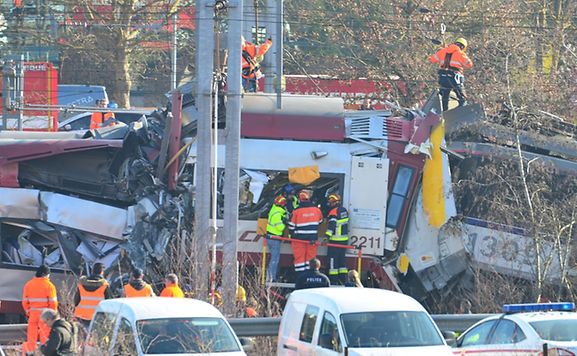Missed stop sign cause of fatal train crash
Photo: Michel Thiel
Updated on Tuesday, 14 February, 2017 at 15:13
A passenger train and a freight train collided between Bettembourg (L) and Zoufftgen (FR) on Tuesday morning at approximately 8:40am.
According to information provided jointly by the police and CFL, there are four injured. Of these four, two are seriously injured.
Police later confirmed that one of the injured did not survive the accident.
In a press conference at 12:30pm , Interior Minister Dan Kersch and Infrastructure Minister François Bausch confirmed the driver of the passenger train, a Luxembourgish CFL employee, did not survive the crash.
CFL latter expressed in a statement at 2:45pm that "The recordings of the traffic management system showed that the passenger train CFL TER 88807 to Thionville, involved in the accident, passed a stop signal." The reason for this is still unknown, however there is an ongoing investigation.
Both trains will now be pulled apart to reach the victim.
The incident occurred near the Bettembourg yard and the French border zone of Zoufftgen, where, in 2006, a similar collision occurred, resulting in the death of six people.
No alarm set off before crashNo alarm was triggered in the run-up to the crash, according to officials.
A French conductor on the passenger train managed to exit the front of the train before impact, although she did sustain some injuries.
She informed the Bettembourg post [signal box] f the crash at 8:45am. All procedural measures were immediately triggered, and 60-70 emergency service workers were deployed within a short time.
The first intervention team arrived at the scene at 9:06am.
The freight train from France was heading for the "triage" [marshalling yard] in Bettembourg. The train comprised one locomotive and 27 empty carriages, weighing 610 tonnes in total.
The passenger train, coming from Luxembourg, was heading for France.
Minister Bausch declined to speculate on the reasons for the accident. He said investigative teams were already at the scene to carry out their work.
In the wake of the collision at Bettembourg, the route from Luxembourg to Thionville will be suspended for 48 hours.
CFL has put on extra buses for passengers.
There are a lot of pictures in that report showing the serious damage to both trains. The view in the quote above shows the damage to the fronts of the two trains.


